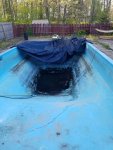Has anyone heard of old pools being finished via rubber/epoxy applied directly to a poured concrete shell?
I'm planning a repair/repaint of my previously painted pool and I'm trying to figure out if my pool has ever been plastered. I've been researching pool stuff on and off for a couple of years now, and I've been unable to determine my pool surface.
To my knowledge, the pool was installed in 1969 when the house was constructed, and I realized today that it looks like it was poured in place. There are slightly noticeable seams where the corners meet the walls and the corners are 45 degrees instead of 90 degrees/rounded (presumably 45s are much easier to make with forms). There is no de-lamination in the surface, just some minor cracks and pitting (presumably frost-related from sitting partially empty for several years). I feel like a plaster surface would be in much rougher shape after being subjected to free/thaw for a few years. I started grinding out cracks and small divots in 2017 to prepare to patch them (and then got busy with work for 18 months) and it appears that there is no plaster layer (there is aggregate within 1/4" of the surface).
Pic from when I mostly drained it in 2017:

The crack in the foreground has already been enlarged with a grinder. The deep end surface is in much better condition since it has been consistently underwater while the pool has been unused. |I will grab a close-up surface shot tomorrow.
Thanks!
I'm planning a repair/repaint of my previously painted pool and I'm trying to figure out if my pool has ever been plastered. I've been researching pool stuff on and off for a couple of years now, and I've been unable to determine my pool surface.
To my knowledge, the pool was installed in 1969 when the house was constructed, and I realized today that it looks like it was poured in place. There are slightly noticeable seams where the corners meet the walls and the corners are 45 degrees instead of 90 degrees/rounded (presumably 45s are much easier to make with forms). There is no de-lamination in the surface, just some minor cracks and pitting (presumably frost-related from sitting partially empty for several years). I feel like a plaster surface would be in much rougher shape after being subjected to free/thaw for a few years. I started grinding out cracks and small divots in 2017 to prepare to patch them (and then got busy with work for 18 months) and it appears that there is no plaster layer (there is aggregate within 1/4" of the surface).
Pic from when I mostly drained it in 2017:

The crack in the foreground has already been enlarged with a grinder. The deep end surface is in much better condition since it has been consistently underwater while the pool has been unused. |I will grab a close-up surface shot tomorrow.
Thanks!

